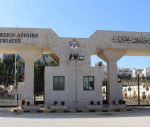You are here
Aleppo Citadel key crusader fortification, prison, cultural hub
By Saeb Rawashdeh - Oct 26,2024 - Last updated at Oct 26,2024

A view of a wall alongside Aleppo fortress (Photo courtesy of ACOR)
The Aleppo Citadel was an important fortification during Crusades and it held back repeated assaults by Crusaders' armies. Prominent Crusaders were kept imprisoned in the citadel, among them the King of Jerusalem Baldwin II (ruled 1118-1131), who spent two years in Aleppo. The last ruler of Edessa Joscelin II was also imprisoned in the citadel as well as Raynald of Chatillon.
Nur Ad Din (1118-1174), a devoted enemy of Francs and member of Zengi clan, rebuilt Aleppo and fortified the citadel. Among his architectural achievements mediaeval sources cite high brick-walled entrance ramp, a palace and a racecourse likely covered with grass.
Furthermore, during the rule of Saladin's son Zahir Ghazi between 1193 and 1225 the citadel was reconstructed and additional walls were added. Sultan Ghazi strengthened the walls, smoothed the surface of the outcrop and covered sections of the slope at the entrance area with stone cladding. The depth of the moat was increased, connected with water canals and spanned by a tall bridge-cum-viaduct, which today still serves as the entrance into the citadel.
Few decades earlier, Aleppo, with Mosul and Damascus, was a centre for Zengin dynasty who controlled Upper Mesopotamia and parts of Levant before it took over Egypt in 1169.
Islamic chroniclers
For a long time, scholars of mediaeval Islamic history have been aware of the names of important chronicles which are no longer extant but of which fragments are still to be found in excerpted narratives preserved in the writings of later generations of mediaeval Islamic historians.
One of such chroniclers was a Seljuq historian Muhammad Abd Al Malik Al Hamadhani who died in 1121. Another significant historian was Ibn Abi Tayy (1180-1228) a Shiite who wrote in 13th century and described the history of Aleppo. Abi Tayy dealt with policies of Zengis towards Shiite population of Aleppo.
"A second resource for discussion in this chapter will be the monumental inscriptions in Aleppo which date from Zengid times. Previous research on such inscriptions has tended to be confined to their decipherment alone and there has been little attempt to analyse the links between the epigraphic and textual evidence for Zengid and early Ayyubid treatment of the Aleppan Shiites," noted Carole Hillenbrand, a British historian specialised in Islamic history.
Hillenbrand's academic interest include: the Crusades; Islamic political thought; mediaeval and modern concepts of jihad; Arabic and Persian travelogues.
Ghazi employed Abi Tayy as an administrator, and among his works is the biography of Saladin and "Mines of gold"-a chronicle of his home city Aleppo.
"Ibn Abi Tayyalsoprovides detailed documentation on the struggle for power in Aleppo after thedeath of Nur Al Din in 1174, as well as the city’s eventual conquest by Saladinand the subsequent rule of his son, Ghazi," Hillenbrand said, noting that Sunni historians used Tayy as a source about Aleppo and Syria.
Shiites in Aleppo were divided in many groups but some Sunni chroniclers did not separate them into different groupings and doctrines.
By the time of the Crusades, Shiite Islam was already well established in Syria, and especially in the region of Aleppo.
"Indeed, Halm has plausibly argued that by the 12th century Shiites were numerous in northern Syria and that in Aleppo itself perhaps they even outnumbered its Sunni inhabitants. The spread of Shiitism in various forms in the Aleppan region went back at least to the rule of the Arab Hamadanid princes in the 10th century, one of whom, Saʿd Al Dawla, ruled in 969," Hillenbrand underlined.
After the weakening of Seljuq power and unity in 1092 caused by the deaths of Nizam Al Mulk and Malikshah in quick succession, the Turkish princes and warlords who ruled Syria were keen not to upset their subject populations.
In order to maintain the unity of their subjects, Seljuq rulers were flexible in terms of doctrinal differences.
"However, the religious situation was complicated by the activities of competing Shiite groups, both from Egypt where, after 1094 and the Nizarischism, one form of Ismaili teachings prevailed under the so-called Mustalians, and also from Iran, where the Nizaris of Alamūt under Hassna Sabariwere pursuing vigorous
proselytising campaigns. From the first decade of the 12th century onwards, Persian Nizaris focused their sights on Aleppo and they soon came to control the city,"Hillenbrand said.
Related Articles
ALEPPO — Before the war, Aleppo's ancient walled citadel drew in armies of visitors to one of the Middle East's greatest treasures.But for t
AMMAN — One of the first major campaigns of the First Crusade was the siege of Antioch in spring of 1098.
ALEPPO/AMMAN — The Syrian army and its allies made new gains in Aleppo on Sunday, forcing rebels back into an ever shrinking pocket crammed















